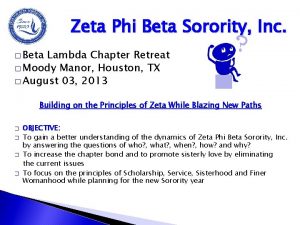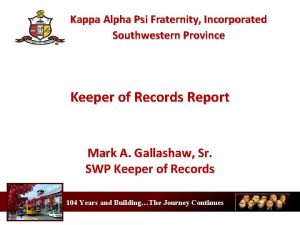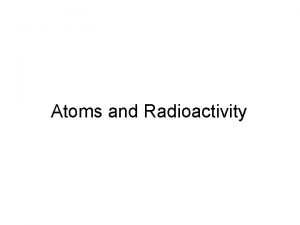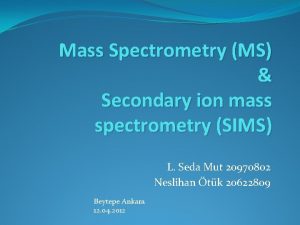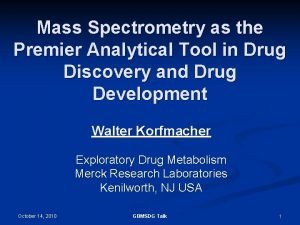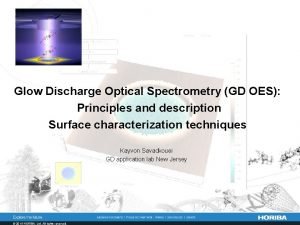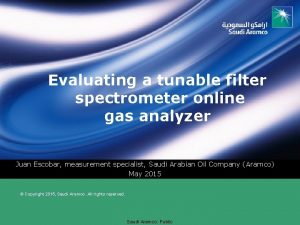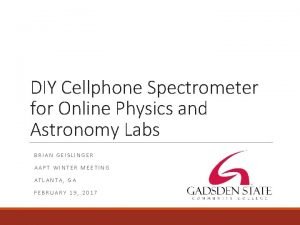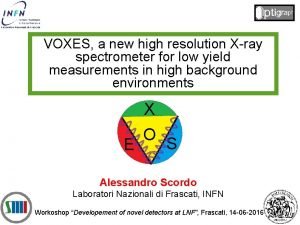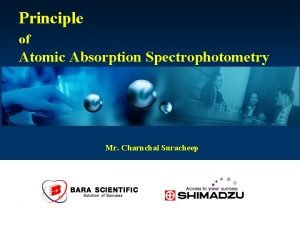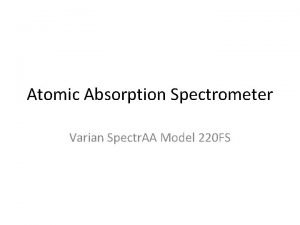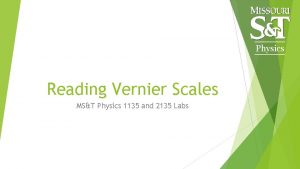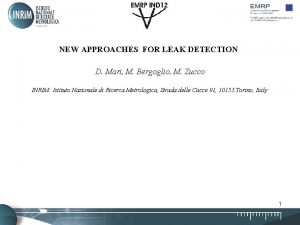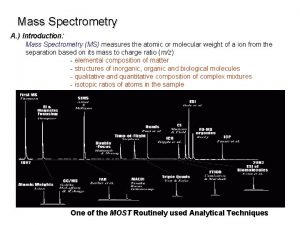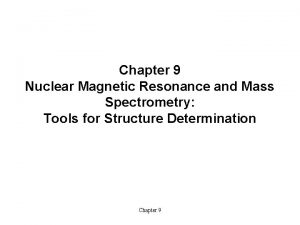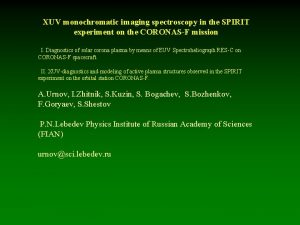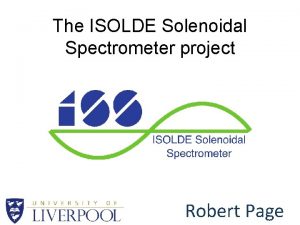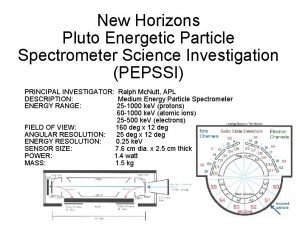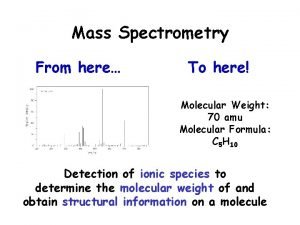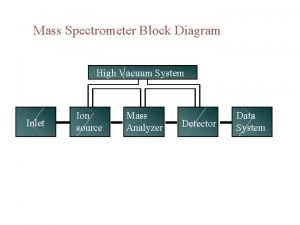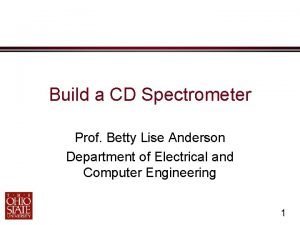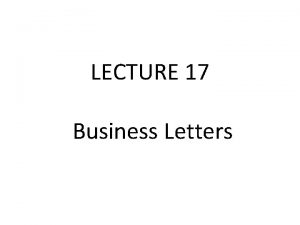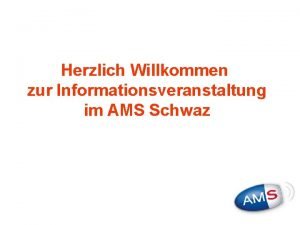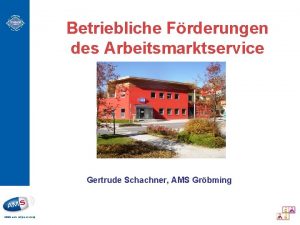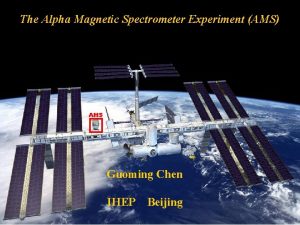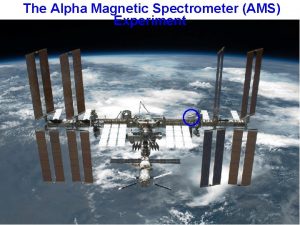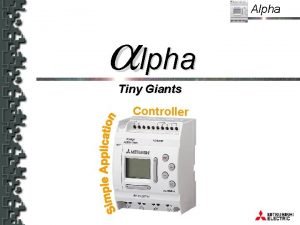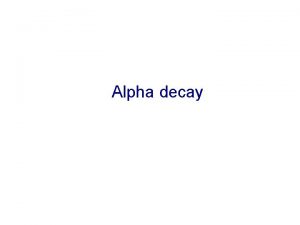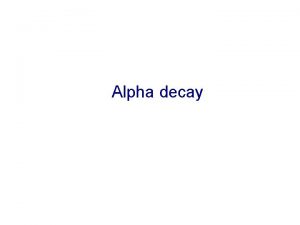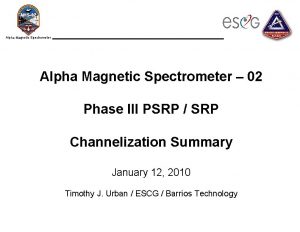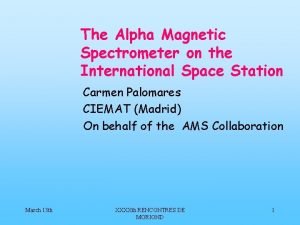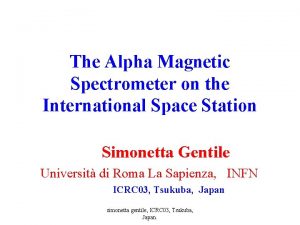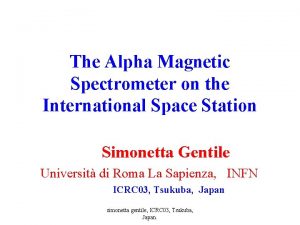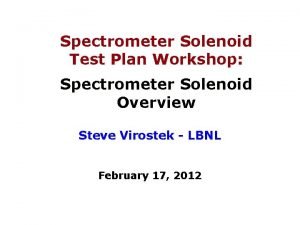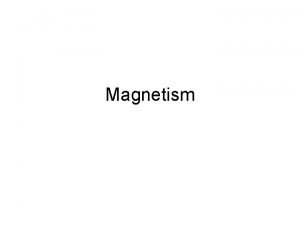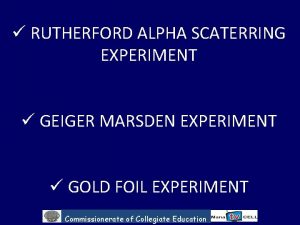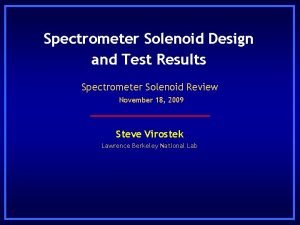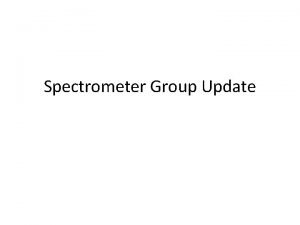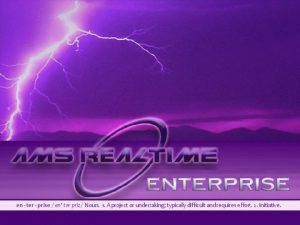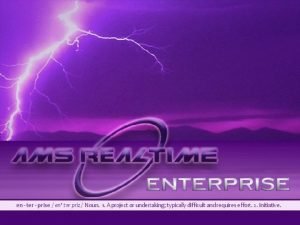The Alpha Magnetic Spectrometer AMS Experiment Outline Overview











































- Slides: 43

The Alpha Magnetic Spectrometer (AMS) Experiment

Outline • • Overview of cosmic ray science AMS-02 Detector Measurements to be made by AMS-02 Current status of AMS-02 10/13/11

Fundamental Science on the International Space Station γ Hubble, Chandra, AMS On Earth we live under 60 miles of air, which is equivalent to 30 feet of water. This absorbs all the charged particles.

The Highest Energy Particles are Produced in the Cosmos Cosmic Rays with energies of 100 Million Te. V have been detected by the Pierre Auger Observatory in Argentina, which spans an area of 3, 000 km 2.

Early History of Fundamental Discoveries from Charged Cosmic Rays in the Atmosphere 1912: Discovery of Cosmic Rays 1932: Discovery of positron 1947: Discovery of pions Discoveries of 1936: Muon (μ) 1949: Kaon (K) 1949: Lambda (Λ) 1952: Xi (Ξ) 1953: Sigma (Σ) As accelerators have become exceedingly costly, the ISS is a valuable alternative to study fundamental physics. e

AMS: A Te. V precision, multipurpose particle physics spectrometer in space. TRD Identify e+, e- Particles and nuclei are defined by their charge (Z) and energy (E ~ P) TOF Z, E 1 TRD Silicon Tracker Z, P Magnet ±Z TOF 2 5 -6 7 -8 Tracker 3 -4 TOF ECAL E of e+, e-, γ RICH 9 ECAL Z, P are measured independently by the Tracker, RICH, TOF and ECAL RICH Z, E

Photo Montage!! 10/13/11

Photo Montage!! 10/13/11

Photo Montage!!

Photo Montage!! 10/13/11

Photo Montage!! 10/13/11

POCC at CERN in Geneva control of AMS

AMS Physics examples 1 - Precision study of the properties of Cosmic Rays Φ (sr-1 m-2 sr-1 Ge. V-1) i. Composition at different energies (1 Ge. V, 100 Ge. V, 1 Te. V) AMS will measure of cosmic ray spectra for nuclei, for energies from 100 Me. V to 2 Te. V with 1% accuracy over the 11 -year solar cycle. 25 /n V) e (G E kin These spectra will provide experimental measurements of the assumptions that go into calculating the background in searching for Dark Matter, i. e. , p + C →e+, p, …

D/p AMS-02 Deuteron to Proton Ratio (98) (Projection)

Cosmic Ray Propagation • Necessary to understand how cosmic rays travel from their sources to Earth. • Notably, there are diffusion coefficients, and there are time constants which need to be accurately measured to determine the background cosmic ray flux.

Precision study of the properties of Cosmic Rays ii. Cosmic Ray confinement time (Projection)

Precision study of the properties of Cosmic Rays iii. Propagation parameters (diffusion coefficient, galactic winds, …) (Projection)

Identifying Sources with AMS Example: Pulsars in the Milky Way 1 Neutron star sending radiation in a periodic way. TRD Currently measured to energies of ~ Ge. V with precision of a millisec. TOF 2 AMS: energy spectrum up to 1 Te. V and pulsar periods measured with μsec precision 5 -6 7 -8 Tracker 3 -4 TOF RICH 9 ECAL Unique Features: 17 X 0, 3 D ECAL, Measure γ to 1 Te. V, A factor of 1, 000 improvement in Energy and Time

The diffuse gamma-ray spectrum of the Galactic plane up lim per its AMS-02 Space Experiments Ground Experiments T. Prodanovi´c et al. , astro-ph/0603618 v 1 22 Mar 2006

Testing Quantum Gravity with photons ØTwo approaches are trying to elaborate quantum gravity: Loop Quantum Gravity && String Theory. ØBoth of them predict the observed photon velocity depends on its energy. ØLoop Quantum Gravity: it might imply the discrete nature of space time tantamount to an ‘‘intrinsic birefringence’’ of quantum space time. For a gamma ray burst at 10 billion ly away and energy of ~200 ke. V: A delay between the two group velocities of both polarizations that compose a plane wave of 10 ms.

Testing String Theory with Photons ØString Theory: Photon’s foamy structure at the scale of Planck length A non-trivial refractive index when propagating in vacuum. We also need to take into account the red shift effect. The time lag is:

What can be used as a photon source? ØGamma ray burst (e. g. blazar) is suitable for this study: 1. Very bright – good for statistics and trigger; 2. Cosmological Distance – large enough time lags; 3. The light curves have spikes – easy to measure the time lags.

Blazars + Gamma Ray Bursts • Blazar: an Active Galactic Nuclei with Radio and Gamma emission and a jet oriented towards the Earth • Strong emission from radio to gamma wavelengths during Flares • Examples: Mrk 421, Mrk 501, 3 C 273 detected by Air-shower Cerenkov Telescopes Physics: - astrophysical studies (jet production, inter-galactic absorption) - from flares (periods of strong emission) access to Quantum Gravity AMS: energy spectrum for blazars in the 100 Me. V – 1 Te. V and pointing precision of few arcsec >5 GRBs/year in Ge. V range with 1% precision in energy and time-lags with μsec time precision (from GPS) Jet

Quantum Gravity – time lags The Time Lags as a function of Energy with photons emitted by Blazars or GRBs may be seen in light curves measured for 2 different energy range: Time lag Δt Mean E 1 Mean E 2 > mean E 1 Photon arrival time t Basic formula: mean time lag = Δt = L/c ΔE/EQG (L distance of the source, ΔE is mean energy difference and EQG is Quantum Gravity scale)

AMS data on ISS Photon 40 Ge. V, 23 May Direction reconstructed with 3 D shower sampling

The leading candidate for Dark Matter is a SUSY neutralino ( 0 ) e+/( e+ + e−) Collisions of 0 will produce excess in the spectra of e+ different from known cosmic ray collisions Col lisio n of e+ Energy [Ge. V] AMS data on ISS Cos mic R ays 1 Te. V

Detection of High Mass Dark Matter from ISS e+ /(e+ + e-) AMS-02 Collision m =200 Ge. V of Cosmi c m =800 Ge. V m =400 Ge. V Rays e+ Energy (Ge. V) Events sample in first week

Kaluza-Klein Bosons are also Dark Matter candidates case 2 Te. V Scale Singlet Dark Matter Eduardo Pontón and Lisa Randall ar. Xiv: 0811. 1029 v 2 [hep-ph] 20 Jan 2009 - Fig. 5 Positron fraction e+/(e+ + e-) 10 -1 AMS-02 (18 yrs) 500 Ge. V Fig. 5 10 -2 10 -3 10 sdm_500_18 Yb 102 e+ Energy (Ge. V) 103

AMS data on ISS Electron 240 Ge. V, 22 May

AMS is sensitive to SUSY parameter space that is difficult to study at LHC (large m 0, m 1/2 values) Shaded region allowed by WMAP, etc. F E M K H L M J K I B D G A C At benchmarks “K” & “M” Supersymmetric particles are not visible at the LHC. M. Battaglia et al. , hep-ph/0112013 M. Battaglia et al. , hep-ex/0106207 M. Battaglia et al. , hep-ph/0306219 D. N. Spergel et al. , astro-ph/0603449

p/p Benchmark “M” (not accessible to LHC) AMS spectra with Mχ = 840 Ge. V y 06 K 318 AMS-02 (Projected spectrum from cosmic ray collisions)

Direct search for antimatter: AMS on ISS Collect 2 billion nuclei with energies up to 2 trillion e. V Sensitivity of AMS: If no antimatter is found => there is no antimatter to the edge of the observable universe (~ 1000 Mpc). The physics of antimatter in the universe is based on: The existence of a new source of CP Violation The existence of Baryon, Lepton Number Violation Grand Unified Theory Electroweak Theory SUSY the Foundations of Modern Physics These are central research topics for the current and next generation of accelerators world wide

Physics Example 5 - Search for New Matter in the Cosmos Carbon Nucleus Z/A ~ 0. 5 p uu d Strangelet n u ddu du uu uu d d du u du d u ss u s ud du s d u dd sdu d s uds u u uu d d Z/A < 0. 12 Strangelets: a single “super nucleon” with many u, d & s 33 - Stable for masses A > ~10, with no upper limit Searches - “Neutron” stars may be composed of one big strangelet with terrestrial samples – low sensitivity. with lunar samples – limited sensitivity. in accelerators – cannot be produced at an observable rate. in space – candidates… Stable strange quark matter was first proposed by E. Witten, Phys. Rev. D, 272 -285 (1984) Jack Sandweiss, Yale

AMS data on ISS Nuclear charge Z=14, Si P = 136 Ge. V/c

AMS data on ISS Nuclear charge P = 119 Ge. V/c Z=8, O

AMS data on ISS May 19 to 24, 2011 10/13/11

AMS has collected over 10 billion events First 9 months of AMS operations

First Data from AMS and detector performance The detectors function exactly as designed. Therefore, every year, we will collect 1. 5*10+10 triggers and in 20 years we will collect 3*10+11 triggers. This will provide unprecedented sensitivity to search for new physics.

The Cosmos is the Ultimate Laboratory. Cosmic rays can be observed at energies higher than any accelerator. The issues of antimatter in the universe and the origin of Dark Matter probe the foundations of modern physics. AMS is the only large scientific experiment to study these issues directly in space.

What is AMS doing now? • Calibration, Calibration! • AMS aims to measure charged particles up to 1 TV rigidity, this requires one to know the position of the tracker to better than 5 microns in order to claim a sagitta measurement down to 10 microns! • AMS is heated unevenly, and to great extremes, Movements created by different heating conditions must also be known to better than 5 microns.

Uneven Heating of AMS aboard the ISS

When will the data be ready?

When will the data be ready? As Late as possible!!
 Zeta closing prayer
Zeta closing prayer Npte pharmacology
Npte pharmacology Alpha kappa alpha membership intake process manual
Alpha kappa alpha membership intake process manual Omega phi alpha ucf
Omega phi alpha ucf Alpha kappa alpha information session
Alpha kappa alpha information session Lambda phi omega aka
Lambda phi omega aka Alpha phi alpha
Alpha phi alpha Pi eta omega
Pi eta omega Alpha omega alpha osteopathic
Alpha omega alpha osteopathic Alpha kappa alpha slides
Alpha kappa alpha slides Alpha decay
Alpha decay Coercivity
Coercivity Weber unit of magnetic flux
Weber unit of magnetic flux Magnetic moment and magnetic field relation
Magnetic moment and magnetic field relation Magnetic field and magnetic force
Magnetic field and magnetic force Mass spectrometer schematic diagram
Mass spectrometer schematic diagram Principal of mass spectroscopy
Principal of mass spectroscopy Quadrupole mass spectrometer
Quadrupole mass spectrometer Gd-oes
Gd-oes Plane transmission grating is
Plane transmission grating is Tuneable filter spectrometer
Tuneable filter spectrometer Cell phone spectrometer
Cell phone spectrometer Xray spectrometer
Xray spectrometer Principle of aas
Principle of aas Varian atomic absorption spectrometer
Varian atomic absorption spectrometer Physics 1135 mst
Physics 1135 mst Ftir spectrometer
Ftir spectrometer Quadrupole mass analyzer
Quadrupole mass analyzer Mass spectrometer
Mass spectrometer Color 29122001
Color 29122001 Spectrometer
Spectrometer Spectrometer
Spectrometer Mass spectrometer formula
Mass spectrometer formula Spectrometer
Spectrometer Butyl isopropyl ether
Butyl isopropyl ether Cereal box spectrometer
Cereal box spectrometer Scrap heap magnet circuit diagram
Scrap heap magnet circuit diagram Sandwich paragraph example
Sandwich paragraph example Ams 4:23
Ams 4:23 Business letters introduction
Business letters introduction Ams filing requirements
Ams filing requirements Ams jobroboter
Ams jobroboter Block paragraph format
Block paragraph format Ams gröbming
Ams gröbming
